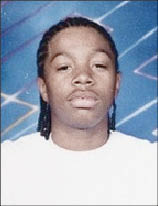Probability is Chicago’s latest weapon in the ongoing fight against youth violence – and the city is banking millions of federal Recovery Act dollars on its success.
Under a new program designed to predict which students are most likely to become victims of violence, Chicago hopes to put the social equivalent of a giant bulletproof vest around those teens.
Chosen because they share the characteristics of youths who have been shot during the past five years, the youths – among the most academically estranged in the city – will be paired with mentors 16 hours a week.
The plan may add a critical layer of protection for the youths it serves. However, like a bulletproof vest, it has no guarantee that it will keep the youths from harm.
And while the program is generally welcomed in a city where youth violence has been endemic for decades, already there is controversy over which youth-serving agencies will get some of the money set aside to fund the program.
Researchers find reason to be guardedly optimistic about the plan’s ability to reduce the number of youths who fall victim to violence.
Caught on a Cell Phone
“If you read the studies on [prediction models] where you focus on certain individuals, with those individuals, you do get better results,” says Nancy Abbate, a DePaul University sociology professor who specializes in the treatment and prevention of juvenile delinquency. “But the entire social fabric of the community won’t change, and there will be other times where things will happen.”
Indeed, if anything underscores the potential for such a “things-will-happen” anomaly, it would be the beating death in September of 16-year-old honor roll student Derrion Albert, which was captured on a cell phone video and disseminated worldwide, just as the city was trying to land the 2016 Summer Olympics.
The Chicago school district’s violence prevention plan, called the Safety and Security Strategy, draws from data showing that the vast majority of the city’s young shooting victims were shot outside of school hours – that is, earlier than two hours before or later than two hours after the school day.
But Albert was killed on his way to a neighborhood recreation center right after school. And he was beaten with feet, fists and splintered railroad ties – not shot – after being caught in the middle of a melee between two rival neighborhood cliques. Police say he was an innocent bystander and wasn’t involved in either group.
Albert clearly would not have been considered “at risk” by the Chicago plan’s standards, although the youths arrested and charged in his death might have been. While the plan seeks to prevent youths from becoming victims, a possible side effect could be to prevent some of the targeted youths from becoming perpetrators.
Albert’s death occurred just weeks after the Safety and Security Strategy was announced, but before any of it had been put in place.
The Underlying Study
Like many studies before it, the study for the Chicago plan found that most young gunshot victims were Hispanic or African-American males.
But Chicago Public Schools (CPS) used its own records to identify other, more meaningful, characteristics that were common among young shooting victims and that go beyond the generalities of race and gender.
The school system found that Chicago’s young gunshot victims were nearly six times as likely as their high school peers to be two or more school credits “off track.” It also found that gunshot victims were nearly three times as likely to be absent from school (42 percent versus 16 percent for the total high school population); and more than eight times as likely to have been cited from four to six times for school-related incidents as their peers. They were also 1.5 times as likely to be special education students and slightly more likely – 7 percent versus 5 percent – to be homeless.
The school system also found that students at 25 percent of its high schools accounted for 80 percent of the total number of youth homicide and aggravated battery victims.
Such information enables school officials and, by extension, youth workers, to use current school records to identify all the youths who fall within the categories of being off-track, truant, in trouble or in special education and then provide them with services, as called for in the Safety and Security Strategy.
The probability model used by CPS found that 200 CPS students have a 20 percent or higher chance of being shot within the next two years, and thus are at “ultra-high risk.” Another 1,000 have a 7.5 percent to 20 percent chance of being shot within the next two years, placing them at “very high risk.” And 8,500 more youths have a 1 percent to 7.5 percent chance of being shot during the next two years, placing them at “high risk.”
 |
|
Derrion Albert |
About 100,000 youths were identified as being at “minimal” or “lower risk” (a less than 1 percent chance) of being shot during the next two years. However, as noted in a March 2009 University of Chicago Crime Lab report, Gun Violence Among School-Age Youth in Chicago, “no Chicago youth is entirely safe from the problem of gun violence.”
“The Crime Lab’s original data analysis suggests that perhaps as many as one out of every five youths killed by gunfire in Chicago was an innocent bystander and not the intended target of the shooter,” says the report.
CPS says more than 500 of its students have been shot over the past two years.
The number of 11- to 20-year-olds killed in Chicago rose from 88 in 2007 to 136 in 2008, according to Chicago police, but the number of youth homicides in Chicago is reportedly on the decline this year.
The Safety and Security Strategy is just one of a series of violence prevention programs that have been implemented in Chicago over the years, with varying and often hard-to-decipher results – a problem faced in many cities. (See story on these pages.) Past programs range from those that use “teen teachers” to reach out to their peers to one called the Youth Violence Prevention Program, that pays youths to get good grades and withholds payments for getting in trouble.
The Role of Youth Workers
At the grassroots level, one such program is Kids Off the Block, which provides programs such as a campaign called “Save-a-Teen, Do Something” for low-income youth. Its founder and president, Diane Latiker, has attended meetings about the new Safety and Security Strategy and says, “Anything will work better than just sitting and doing nothing.”
While many details of the CPS strategy have yet to emerge, the plan is not exactly a shot in the dark. CPS Chief Executive Officer Ron Huberman, a former police officer, told the school board at the beginning of the school year that the plan is based on a successful model created by Harrisburg, Pa.-based Youth Advocate Programs Inc. (YAP). Jeff Fleischer, CEO of YAP, says the agency takes a “strength-based” approach in working with youth at risk of incarceration, and says it recruits all staff from the neighborhoods where the youths referred to the program reside. (For more on the agency and its work, search for YAP at https://youthtoday.org.)
The Chicago school board has chosen YAP for a $5 million contract to implement a portion of Chicago’s program, in a move that shows one of the risks of trying to tackle city-wide social problems through contracts – some local service providers and other observers have angrily complained that the contract should go to a Chicago-based agency.
Huberman, the CPS chief, told the school board recently that it’s “our intent” to involve community-based organizations at the grass-roots level, calling them “a critical component of the plan.”
YAP declined to discuss the tentative deal because it’s not finalized, referring questions to CPS, which did not respond to several requests to discuss any parts of the strategy. The plan is part of a larger violence prevention initiative within the school district being funded over two years with Recovery Act money. Huberman has said the plan, which also involves a “culture of calm” component and revamping the way youths are disciplined in school, would cost $60 million over the next two school years.
Youth Today obtained a copy of the tentative contract with YAP, which sounds like the agency is essentially providing professional mentors.
The contract says that for this school year, YAP will provide “advocates” to 250 “students at greatest risk of becoming victims of violence.” It says that “the advocates will be trained professionals who will be assigned to not more than four students each. Among their objectives will be to improve student attendance at school, decrease student behavioral violations, assist in improving each student’s academic performance and to limit the factors that contribute to their increased risk.”
It says advocates should engage each youth for at least 16 hours per week, and also engage parents and legal guardians to discuss the program and each youth’s specific needs.
Earlier Intervention
Deborah Gorman-Smith, a youth violence prevention expert at Chapin Hall at the University of Chicago, says in order for the Safety and Security Strategy to work, it has to include a “comprehensive strategy that spans across developmental periods.”
“There should be general or ‘universal’ programs designed to impact all kids, combined with targeted strategies to impact those at highest risk,” Gorman-Smith said.
The Crime Lab report draws similar conclusions regarding the best time to intervene, suggesting that perhaps the Chicago school district’s plan might be too little, too late.
“Our analysis suggests that another critical turning point seems to occur as children approach middle school age, when both arrest and dropout rates begin to increase,” the Crime Lab report states. “Another important lesson from our analysis is that most ‘criminal careers’ are relatively brief, so that no youth is ever really ‘lost.’
“These findings taken together suggest we should be thinking about interventions that both start early (as young as age 10) and help young people navigate the highest-risk years, which may run through the early 20s.” Huberman told the school board there are plans to eventually implement the program in middle school.
Just providing mentors to youths is not enough by itself, Gorman-Smith said, so the training called for in the YAP program is critically important.
“Mentoring has had mixed results, but what is clear is that those programs that look like they may be effective involve the use of well-trained mentors with ongoing supervision during the program,” she said. “It takes more than pairing a well-meaning person with a child to have effects.”
She said the plan’s call for the youth advocates to work with the youths’ families is also important: “Research has shown that programs that involve families are most effective. Too often programs, particularly those that come out of the schools, do not engage or work with families.”
The Jobs Challenge
The tentative deal also calls for YAP to work with governmental agencies and secure employment for the youths.
“The advocates will also intervene on the students’ behalf with social service agencies as needed as well as with law enforcement and the juvenile justice system,” the tentative agreement states. “YAP will also ensure that each student receives employment and employment training during the term of their advocacy.”
In a depressed economy, will those be real jobs or make-work tasks created for youths in the program?
Tio Hardiman, director of gang mediation and community organization for CeaseFire, a Chicago-based violence reduction program, says when his agency submits a proposal to provide services for the Safety and Security Strategy, it will call for youths to be offered “some type of job as peacekeepers in the neighborhood. … You don’t have any other jobs out there.”
One possible wrinkle: whether Ceasefire employees – 75 percent of whom Hardiman says are ex-offenders – will be allowed to work with Chicago public school students on a formal basis.
“You have to have people out on the front lines that don’t mind running into a crowd to take a stick out of someone’s hand,” Hardiman says.
Beyond intervention, Hardiman says any successful violence prevention initiative has to deal with changing the mindset of the youths. The violence is “learned behavior being transmitted from one generation to another,” he says.
“We have to really, like a surgeon, go in there and meet with the main promoters of that type of mindset and work on behavioral change so they can talk in more positive ways about brothers and sisters from another area,” Hardiman says, referring to the neighborhood rivalry that led to Albert’s death.
Contact: Youth Advocate Programs (717) 232-7580, http://www.yapinc.org; Chicago Public Schools (773) 553-1000, http://www.cps.edu.































